HSBC Bank: Analysis and Development of Sustainability Strategy Report
VerifiedAdded on 2019/09/20
|27
|4955
|196
Report
AI Summary
This report provides a comprehensive analysis of HSBC Bank's sustainability strategy. It begins with an executive summary and introduction outlining the report's objectives. The main analysis includes external analysis using PESTEL and Porter's Five Forces models, as well as internal analysis using SWOT analysis to identify strengths, weaknesses, opportunities, and threats. The report identifies performance gaps and proposes a step-by-step approach for developing an effective sustainability strategy, including stakeholder engagement and system establishment. Challenges in strategy development, such as engagement and consensus, are also discussed. Finally, the report outlines the implementation steps for the sustainability strategy and concludes with a list of references and appendices containing additional analyses. The report emphasizes the importance of sustainable strategies for HSBC's long-term success and highlights the need for effective implementation to achieve desired outcomes.
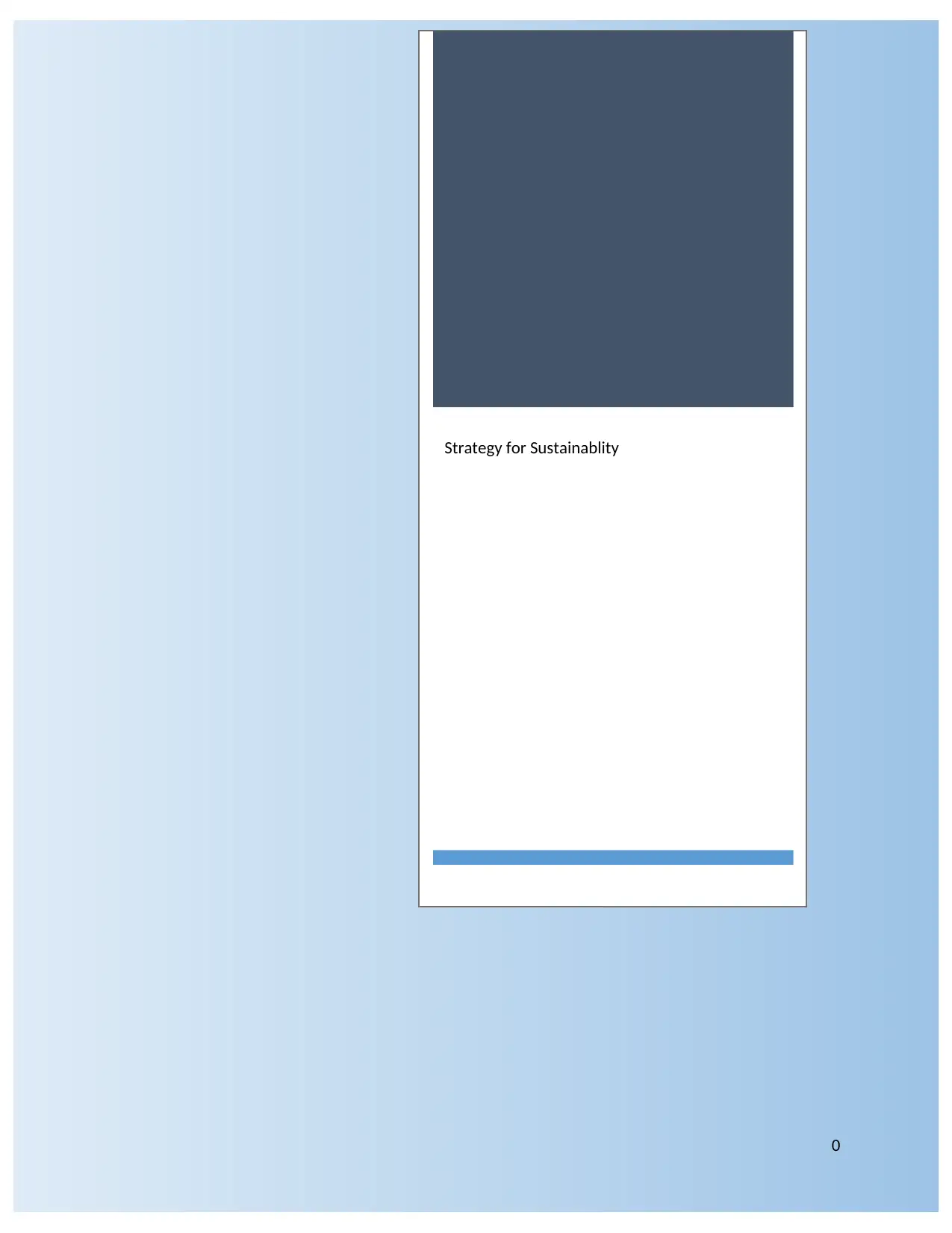
0
Strategy for Sustainablity
Strategy for Sustainablity
Paraphrase This Document
Need a fresh take? Get an instant paraphrase of this document with our AI Paraphraser

1

Table of Contents
Executive Summary.........................................................................................................................1
Introduction......................................................................................................................................2
Main Analysis..................................................................................................................................2
3.1 Question 1 .............................................................................................................................2
External Analysis of HSBC Bank............................................................................................2
Internal Analysis of HSBC Bank.............................................................................................4
Identification of Performance Gaps.........................................................................................4
3.2 Question 2..............................................................................................................................4
3.3 Question 3..............................................................................................................................5
Conclusion.......................................................................................................................................6
References........................................................................................................................................7
Appendices......................................................................................................................................7
2
Executive Summary.........................................................................................................................1
Introduction......................................................................................................................................2
Main Analysis..................................................................................................................................2
3.1 Question 1 .............................................................................................................................2
External Analysis of HSBC Bank............................................................................................2
Internal Analysis of HSBC Bank.............................................................................................4
Identification of Performance Gaps.........................................................................................4
3.2 Question 2..............................................................................................................................4
3.3 Question 3..............................................................................................................................5
Conclusion.......................................................................................................................................6
References........................................................................................................................................7
Appendices......................................................................................................................................7
2
⊘ This is a preview!⊘
Do you want full access?
Subscribe today to unlock all pages.

Trusted by 1+ million students worldwide
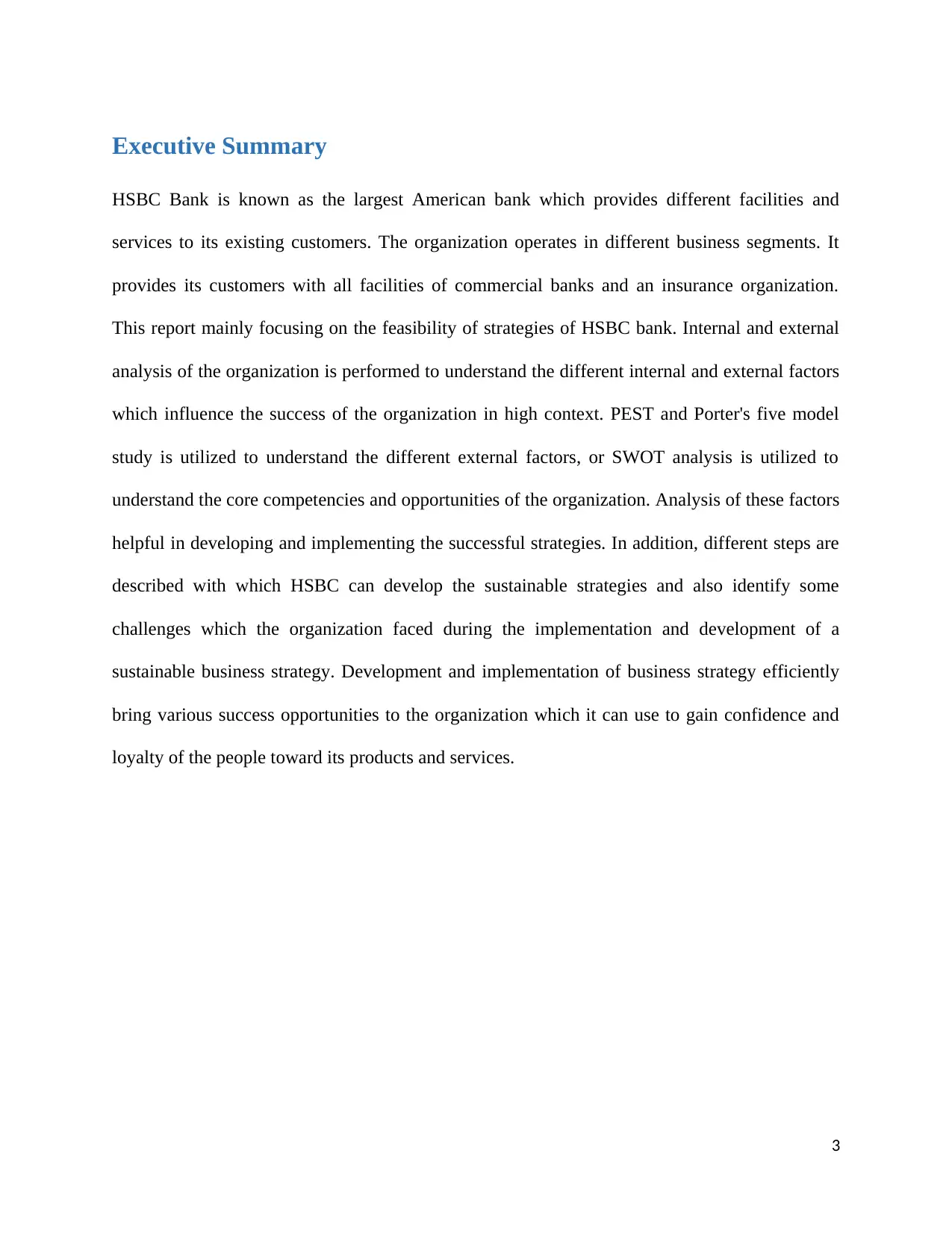
Executive Summary
HSBC Bank is known as the largest American bank which provides different facilities and
services to its existing customers. The organization operates in different business segments. It
provides its customers with all facilities of commercial banks and an insurance organization.
This report mainly focusing on the feasibility of strategies of HSBC bank. Internal and external
analysis of the organization is performed to understand the different internal and external factors
which influence the success of the organization in high context. PEST and Porter's five model
study is utilized to understand the different external factors, or SWOT analysis is utilized to
understand the core competencies and opportunities of the organization. Analysis of these factors
helpful in developing and implementing the successful strategies. In addition, different steps are
described with which HSBC can develop the sustainable strategies and also identify some
challenges which the organization faced during the implementation and development of a
sustainable business strategy. Development and implementation of business strategy efficiently
bring various success opportunities to the organization which it can use to gain confidence and
loyalty of the people toward its products and services.
3
HSBC Bank is known as the largest American bank which provides different facilities and
services to its existing customers. The organization operates in different business segments. It
provides its customers with all facilities of commercial banks and an insurance organization.
This report mainly focusing on the feasibility of strategies of HSBC bank. Internal and external
analysis of the organization is performed to understand the different internal and external factors
which influence the success of the organization in high context. PEST and Porter's five model
study is utilized to understand the different external factors, or SWOT analysis is utilized to
understand the core competencies and opportunities of the organization. Analysis of these factors
helpful in developing and implementing the successful strategies. In addition, different steps are
described with which HSBC can develop the sustainable strategies and also identify some
challenges which the organization faced during the implementation and development of a
sustainable business strategy. Development and implementation of business strategy efficiently
bring various success opportunities to the organization which it can use to gain confidence and
loyalty of the people toward its products and services.
3
Paraphrase This Document
Need a fresh take? Get an instant paraphrase of this document with our AI Paraphraser
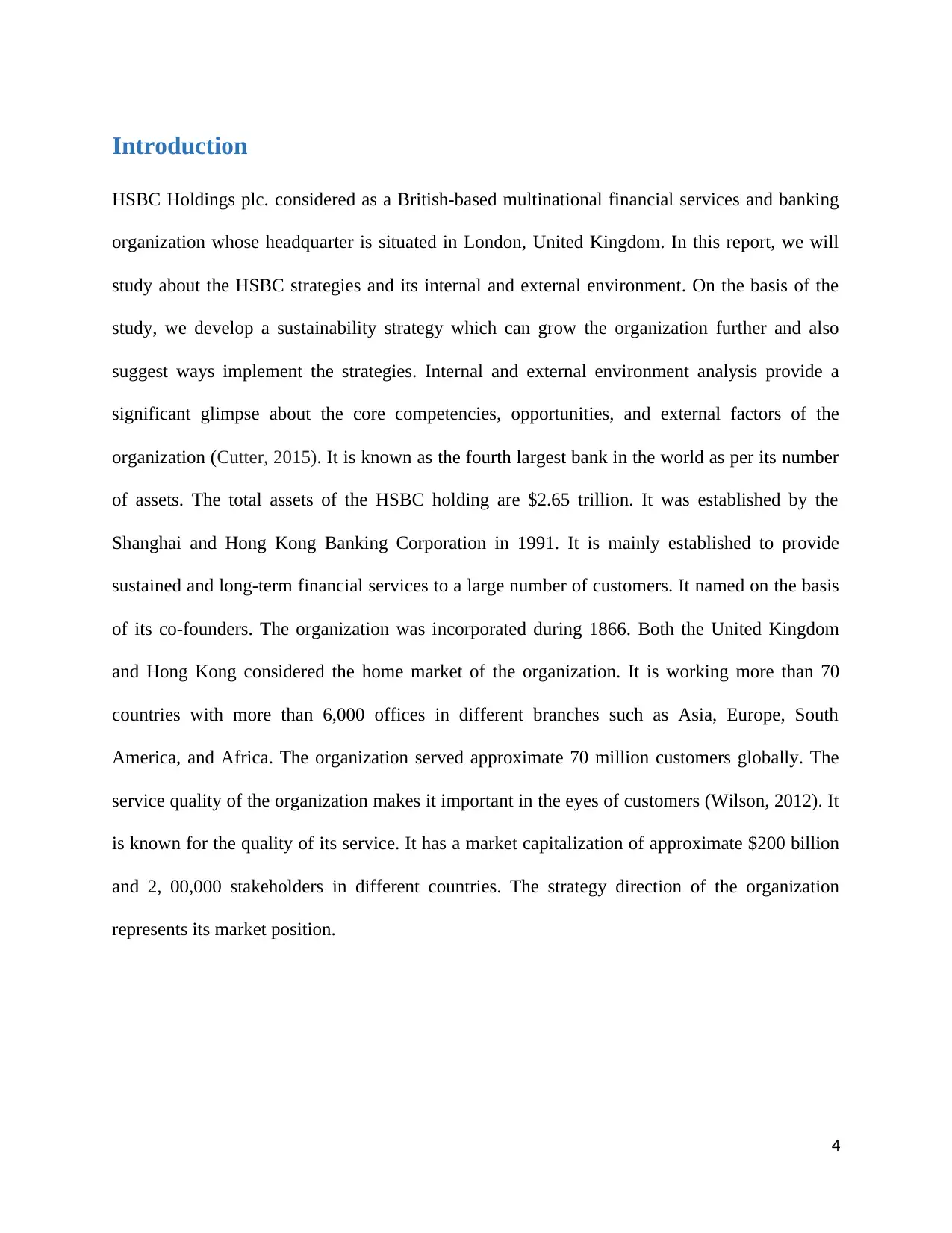
Introduction
HSBC Holdings plc. considered as a British-based multinational financial services and banking
organization whose headquarter is situated in London, United Kingdom. In this report, we will
study about the HSBC strategies and its internal and external environment. On the basis of the
study, we develop a sustainability strategy which can grow the organization further and also
suggest ways implement the strategies. Internal and external environment analysis provide a
significant glimpse about the core competencies, opportunities, and external factors of the
organization (Cutter, 2015). It is known as the fourth largest bank in the world as per its number
of assets. The total assets of the HSBC holding are $2.65 trillion. It was established by the
Shanghai and Hong Kong Banking Corporation in 1991. It is mainly established to provide
sustained and long-term financial services to a large number of customers. It named on the basis
of its co-founders. The organization was incorporated during 1866. Both the United Kingdom
and Hong Kong considered the home market of the organization. It is working more than 70
countries with more than 6,000 offices in different branches such as Asia, Europe, South
America, and Africa. The organization served approximate 70 million customers globally. The
service quality of the organization makes it important in the eyes of customers (Wilson, 2012). It
is known for the quality of its service. It has a market capitalization of approximate $200 billion
and 2, 00,000 stakeholders in different countries. The strategy direction of the organization
represents its market position.
4
HSBC Holdings plc. considered as a British-based multinational financial services and banking
organization whose headquarter is situated in London, United Kingdom. In this report, we will
study about the HSBC strategies and its internal and external environment. On the basis of the
study, we develop a sustainability strategy which can grow the organization further and also
suggest ways implement the strategies. Internal and external environment analysis provide a
significant glimpse about the core competencies, opportunities, and external factors of the
organization (Cutter, 2015). It is known as the fourth largest bank in the world as per its number
of assets. The total assets of the HSBC holding are $2.65 trillion. It was established by the
Shanghai and Hong Kong Banking Corporation in 1991. It is mainly established to provide
sustained and long-term financial services to a large number of customers. It named on the basis
of its co-founders. The organization was incorporated during 1866. Both the United Kingdom
and Hong Kong considered the home market of the organization. It is working more than 70
countries with more than 6,000 offices in different branches such as Asia, Europe, South
America, and Africa. The organization served approximate 70 million customers globally. The
service quality of the organization makes it important in the eyes of customers (Wilson, 2012). It
is known for the quality of its service. It has a market capitalization of approximate $200 billion
and 2, 00,000 stakeholders in different countries. The strategy direction of the organization
represents its market position.
4
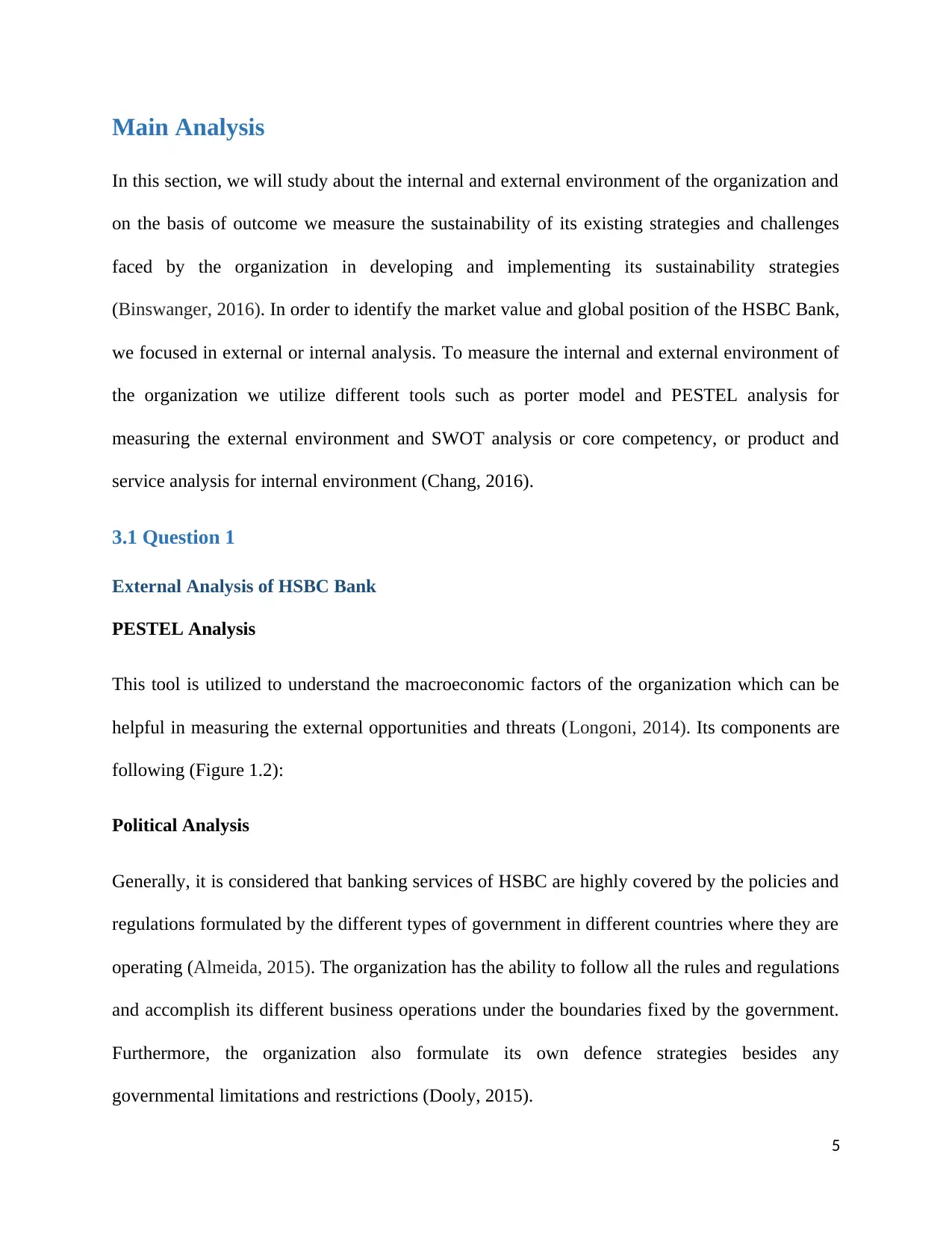
Main Analysis
In this section, we will study about the internal and external environment of the organization and
on the basis of outcome we measure the sustainability of its existing strategies and challenges
faced by the organization in developing and implementing its sustainability strategies
(Binswanger, 2016). In order to identify the market value and global position of the HSBC Bank,
we focused in external or internal analysis. To measure the internal and external environment of
the organization we utilize different tools such as porter model and PESTEL analysis for
measuring the external environment and SWOT analysis or core competency, or product and
service analysis for internal environment (Chang, 2016).
3.1 Question 1
External Analysis of HSBC Bank
PESTEL Analysis
This tool is utilized to understand the macroeconomic factors of the organization which can be
helpful in measuring the external opportunities and threats (Longoni, 2014). Its components are
following (Figure 1.2):
Political Analysis
Generally, it is considered that banking services of HSBC are highly covered by the policies and
regulations formulated by the different types of government in different countries where they are
operating (Almeida, 2015). The organization has the ability to follow all the rules and regulations
and accomplish its different business operations under the boundaries fixed by the government.
Furthermore, the organization also formulate its own defence strategies besides any
governmental limitations and restrictions (Dooly, 2015).
5
In this section, we will study about the internal and external environment of the organization and
on the basis of outcome we measure the sustainability of its existing strategies and challenges
faced by the organization in developing and implementing its sustainability strategies
(Binswanger, 2016). In order to identify the market value and global position of the HSBC Bank,
we focused in external or internal analysis. To measure the internal and external environment of
the organization we utilize different tools such as porter model and PESTEL analysis for
measuring the external environment and SWOT analysis or core competency, or product and
service analysis for internal environment (Chang, 2016).
3.1 Question 1
External Analysis of HSBC Bank
PESTEL Analysis
This tool is utilized to understand the macroeconomic factors of the organization which can be
helpful in measuring the external opportunities and threats (Longoni, 2014). Its components are
following (Figure 1.2):
Political Analysis
Generally, it is considered that banking services of HSBC are highly covered by the policies and
regulations formulated by the different types of government in different countries where they are
operating (Almeida, 2015). The organization has the ability to follow all the rules and regulations
and accomplish its different business operations under the boundaries fixed by the government.
Furthermore, the organization also formulate its own defence strategies besides any
governmental limitations and restrictions (Dooly, 2015).
5
⊘ This is a preview!⊘
Do you want full access?
Subscribe today to unlock all pages.

Trusted by 1+ million students worldwide
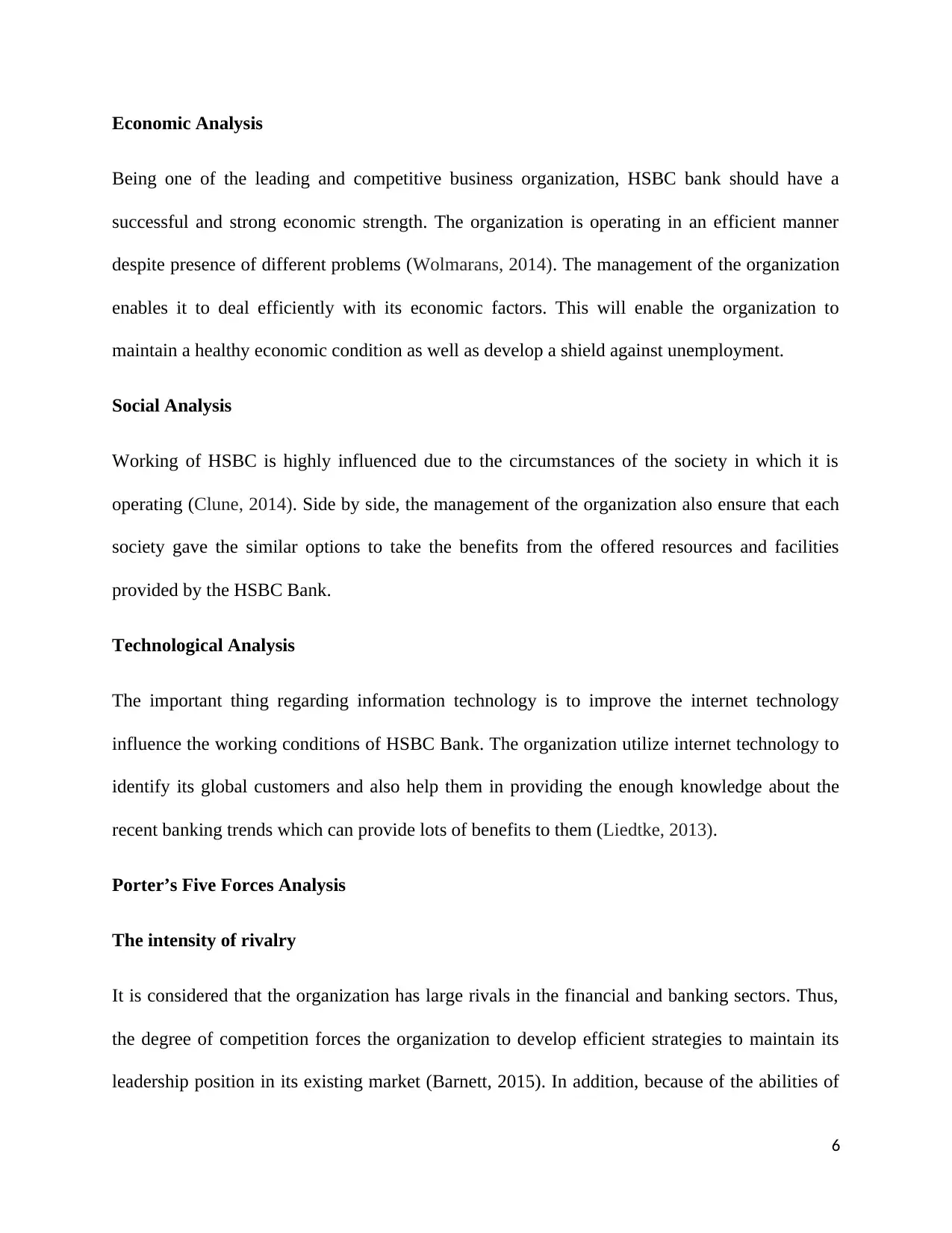
Economic Analysis
Being one of the leading and competitive business organization, HSBC bank should have a
successful and strong economic strength. The organization is operating in an efficient manner
despite presence of different problems (Wolmarans, 2014). The management of the organization
enables it to deal efficiently with its economic factors. This will enable the organization to
maintain a healthy economic condition as well as develop a shield against unemployment.
Social Analysis
Working of HSBC is highly influenced due to the circumstances of the society in which it is
operating (Clune, 2014). Side by side, the management of the organization also ensure that each
society gave the similar options to take the benefits from the offered resources and facilities
provided by the HSBC Bank.
Technological Analysis
The important thing regarding information technology is to improve the internet technology
influence the working conditions of HSBC Bank. The organization utilize internet technology to
identify its global customers and also help them in providing the enough knowledge about the
recent banking trends which can provide lots of benefits to them (Liedtke, 2013).
Porter’s Five Forces Analysis
The intensity of rivalry
It is considered that the organization has large rivals in the financial and banking sectors. Thus,
the degree of competition forces the organization to develop efficient strategies to maintain its
leadership position in its existing market (Barnett, 2015). In addition, because of the abilities of
6
Being one of the leading and competitive business organization, HSBC bank should have a
successful and strong economic strength. The organization is operating in an efficient manner
despite presence of different problems (Wolmarans, 2014). The management of the organization
enables it to deal efficiently with its economic factors. This will enable the organization to
maintain a healthy economic condition as well as develop a shield against unemployment.
Social Analysis
Working of HSBC is highly influenced due to the circumstances of the society in which it is
operating (Clune, 2014). Side by side, the management of the organization also ensure that each
society gave the similar options to take the benefits from the offered resources and facilities
provided by the HSBC Bank.
Technological Analysis
The important thing regarding information technology is to improve the internet technology
influence the working conditions of HSBC Bank. The organization utilize internet technology to
identify its global customers and also help them in providing the enough knowledge about the
recent banking trends which can provide lots of benefits to them (Liedtke, 2013).
Porter’s Five Forces Analysis
The intensity of rivalry
It is considered that the organization has large rivals in the financial and banking sectors. Thus,
the degree of competition forces the organization to develop efficient strategies to maintain its
leadership position in its existing market (Barnett, 2015). In addition, because of the abilities of
6
Paraphrase This Document
Need a fresh take? Get an instant paraphrase of this document with our AI Paraphraser
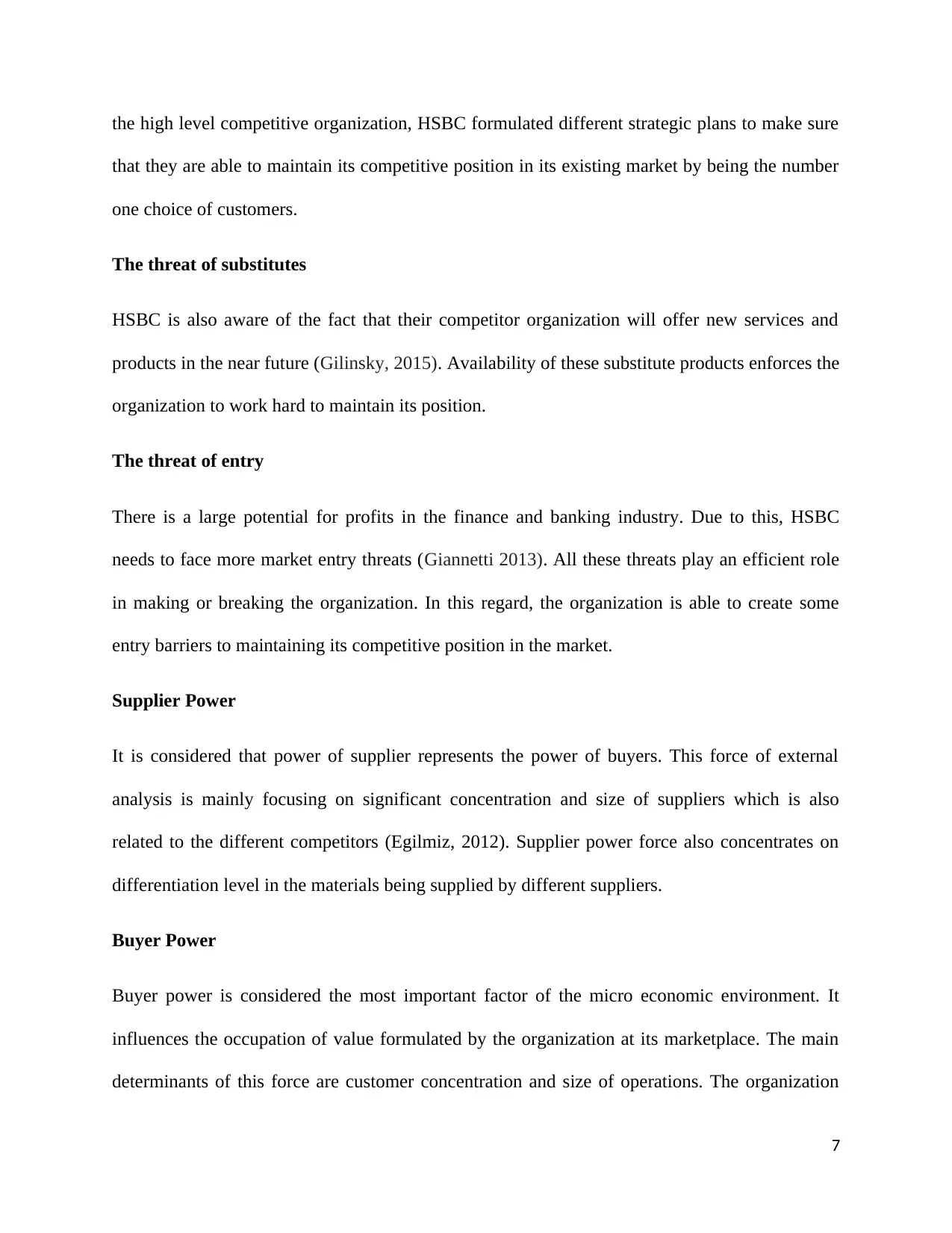
the high level competitive organization, HSBC formulated different strategic plans to make sure
that they are able to maintain its competitive position in its existing market by being the number
one choice of customers.
The threat of substitutes
HSBC is also aware of the fact that their competitor organization will offer new services and
products in the near future (Gilinsky, 2015). Availability of these substitute products enforces the
organization to work hard to maintain its position.
The threat of entry
There is a large potential for profits in the finance and banking industry. Due to this, HSBC
needs to face more market entry threats (Giannetti 2013). All these threats play an efficient role
in making or breaking the organization. In this regard, the organization is able to create some
entry barriers to maintaining its competitive position in the market.
Supplier Power
It is considered that power of supplier represents the power of buyers. This force of external
analysis is mainly focusing on significant concentration and size of suppliers which is also
related to the different competitors (Egilmiz, 2012). Supplier power force also concentrates on
differentiation level in the materials being supplied by different suppliers.
Buyer Power
Buyer power is considered the most important factor of the micro economic environment. It
influences the occupation of value formulated by the organization at its marketplace. The main
determinants of this force are customer concentration and size of operations. The organization
7
that they are able to maintain its competitive position in its existing market by being the number
one choice of customers.
The threat of substitutes
HSBC is also aware of the fact that their competitor organization will offer new services and
products in the near future (Gilinsky, 2015). Availability of these substitute products enforces the
organization to work hard to maintain its position.
The threat of entry
There is a large potential for profits in the finance and banking industry. Due to this, HSBC
needs to face more market entry threats (Giannetti 2013). All these threats play an efficient role
in making or breaking the organization. In this regard, the organization is able to create some
entry barriers to maintaining its competitive position in the market.
Supplier Power
It is considered that power of supplier represents the power of buyers. This force of external
analysis is mainly focusing on significant concentration and size of suppliers which is also
related to the different competitors (Egilmiz, 2012). Supplier power force also concentrates on
differentiation level in the materials being supplied by different suppliers.
Buyer Power
Buyer power is considered the most important factor of the micro economic environment. It
influences the occupation of value formulated by the organization at its marketplace. The main
determinants of this force are customer concentration and size of operations. The organization
7
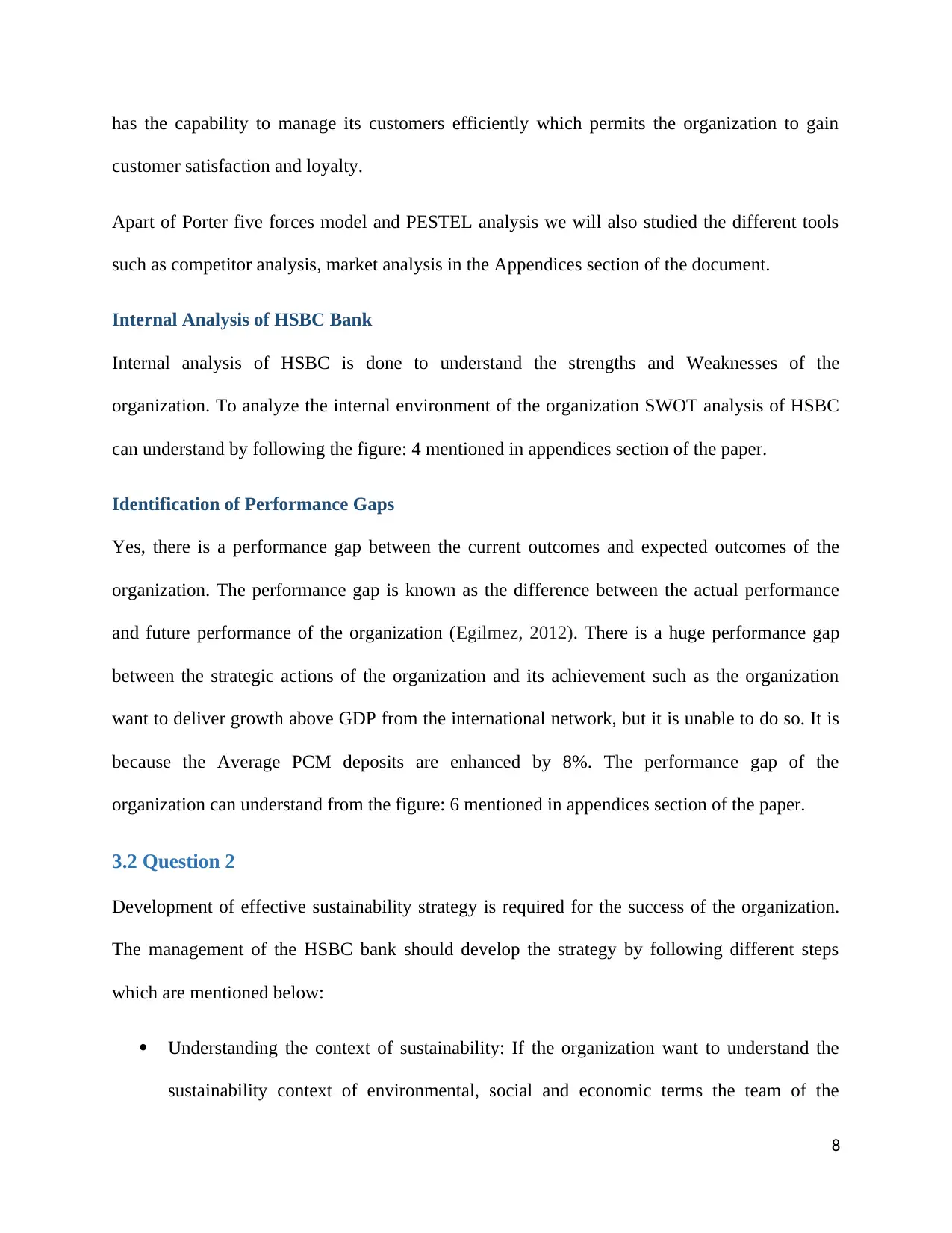
has the capability to manage its customers efficiently which permits the organization to gain
customer satisfaction and loyalty.
Apart of Porter five forces model and PESTEL analysis we will also studied the different tools
such as competitor analysis, market analysis in the Appendices section of the document.
Internal Analysis of HSBC Bank
Internal analysis of HSBC is done to understand the strengths and Weaknesses of the
organization. To analyze the internal environment of the organization SWOT analysis of HSBC
can understand by following the figure: 4 mentioned in appendices section of the paper.
Identification of Performance Gaps
Yes, there is a performance gap between the current outcomes and expected outcomes of the
organization. The performance gap is known as the difference between the actual performance
and future performance of the organization (Egilmez, 2012). There is a huge performance gap
between the strategic actions of the organization and its achievement such as the organization
want to deliver growth above GDP from the international network, but it is unable to do so. It is
because the Average PCM deposits are enhanced by 8%. The performance gap of the
organization can understand from the figure: 6 mentioned in appendices section of the paper.
3.2 Question 2
Development of effective sustainability strategy is required for the success of the organization.
The management of the HSBC bank should develop the strategy by following different steps
which are mentioned below:
Understanding the context of sustainability: If the organization want to understand the
sustainability context of environmental, social and economic terms the team of the
8
customer satisfaction and loyalty.
Apart of Porter five forces model and PESTEL analysis we will also studied the different tools
such as competitor analysis, market analysis in the Appendices section of the document.
Internal Analysis of HSBC Bank
Internal analysis of HSBC is done to understand the strengths and Weaknesses of the
organization. To analyze the internal environment of the organization SWOT analysis of HSBC
can understand by following the figure: 4 mentioned in appendices section of the paper.
Identification of Performance Gaps
Yes, there is a performance gap between the current outcomes and expected outcomes of the
organization. The performance gap is known as the difference between the actual performance
and future performance of the organization (Egilmez, 2012). There is a huge performance gap
between the strategic actions of the organization and its achievement such as the organization
want to deliver growth above GDP from the international network, but it is unable to do so. It is
because the Average PCM deposits are enhanced by 8%. The performance gap of the
organization can understand from the figure: 6 mentioned in appendices section of the paper.
3.2 Question 2
Development of effective sustainability strategy is required for the success of the organization.
The management of the HSBC bank should develop the strategy by following different steps
which are mentioned below:
Understanding the context of sustainability: If the organization want to understand the
sustainability context of environmental, social and economic terms the team of the
8
⊘ This is a preview!⊘
Do you want full access?
Subscribe today to unlock all pages.

Trusted by 1+ million students worldwide
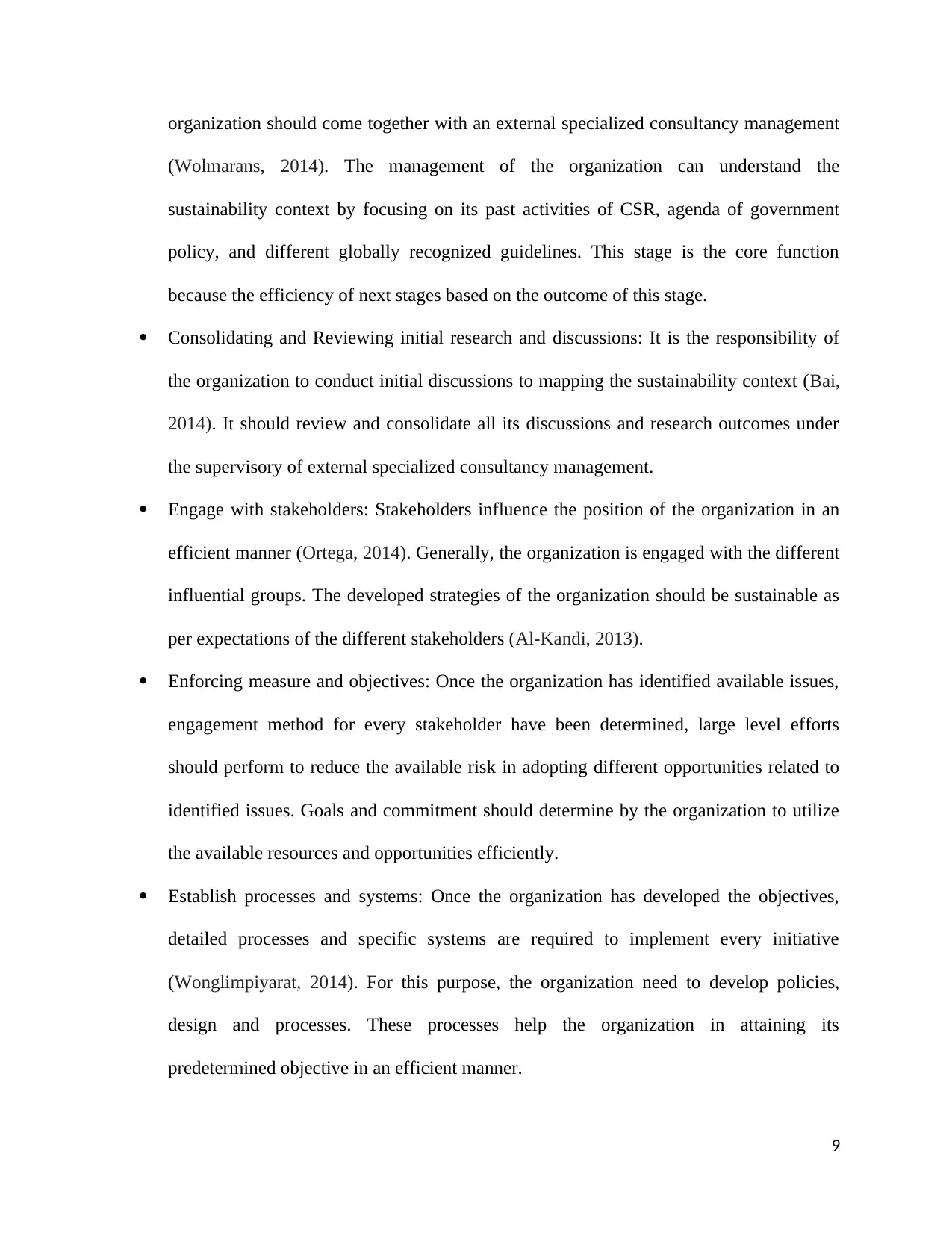
organization should come together with an external specialized consultancy management
(Wolmarans, 2014). The management of the organization can understand the
sustainability context by focusing on its past activities of CSR, agenda of government
policy, and different globally recognized guidelines. This stage is the core function
because the efficiency of next stages based on the outcome of this stage.
Consolidating and Reviewing initial research and discussions: It is the responsibility of
the organization to conduct initial discussions to mapping the sustainability context (Bai,
2014). It should review and consolidate all its discussions and research outcomes under
the supervisory of external specialized consultancy management.
Engage with stakeholders: Stakeholders influence the position of the organization in an
efficient manner (Ortega, 2014). Generally, the organization is engaged with the different
influential groups. The developed strategies of the organization should be sustainable as
per expectations of the different stakeholders (Al-Kandi, 2013).
Enforcing measure and objectives: Once the organization has identified available issues,
engagement method for every stakeholder have been determined, large level efforts
should perform to reduce the available risk in adopting different opportunities related to
identified issues. Goals and commitment should determine by the organization to utilize
the available resources and opportunities efficiently.
Establish processes and systems: Once the organization has developed the objectives,
detailed processes and specific systems are required to implement every initiative
(Wonglimpiyarat, 2014). For this purpose, the organization need to develop policies,
design and processes. These processes help the organization in attaining its
predetermined objective in an efficient manner.
9
(Wolmarans, 2014). The management of the organization can understand the
sustainability context by focusing on its past activities of CSR, agenda of government
policy, and different globally recognized guidelines. This stage is the core function
because the efficiency of next stages based on the outcome of this stage.
Consolidating and Reviewing initial research and discussions: It is the responsibility of
the organization to conduct initial discussions to mapping the sustainability context (Bai,
2014). It should review and consolidate all its discussions and research outcomes under
the supervisory of external specialized consultancy management.
Engage with stakeholders: Stakeholders influence the position of the organization in an
efficient manner (Ortega, 2014). Generally, the organization is engaged with the different
influential groups. The developed strategies of the organization should be sustainable as
per expectations of the different stakeholders (Al-Kandi, 2013).
Enforcing measure and objectives: Once the organization has identified available issues,
engagement method for every stakeholder have been determined, large level efforts
should perform to reduce the available risk in adopting different opportunities related to
identified issues. Goals and commitment should determine by the organization to utilize
the available resources and opportunities efficiently.
Establish processes and systems: Once the organization has developed the objectives,
detailed processes and specific systems are required to implement every initiative
(Wonglimpiyarat, 2014). For this purpose, the organization need to develop policies,
design and processes. These processes help the organization in attaining its
predetermined objective in an efficient manner.
9
Paraphrase This Document
Need a fresh take? Get an instant paraphrase of this document with our AI Paraphraser
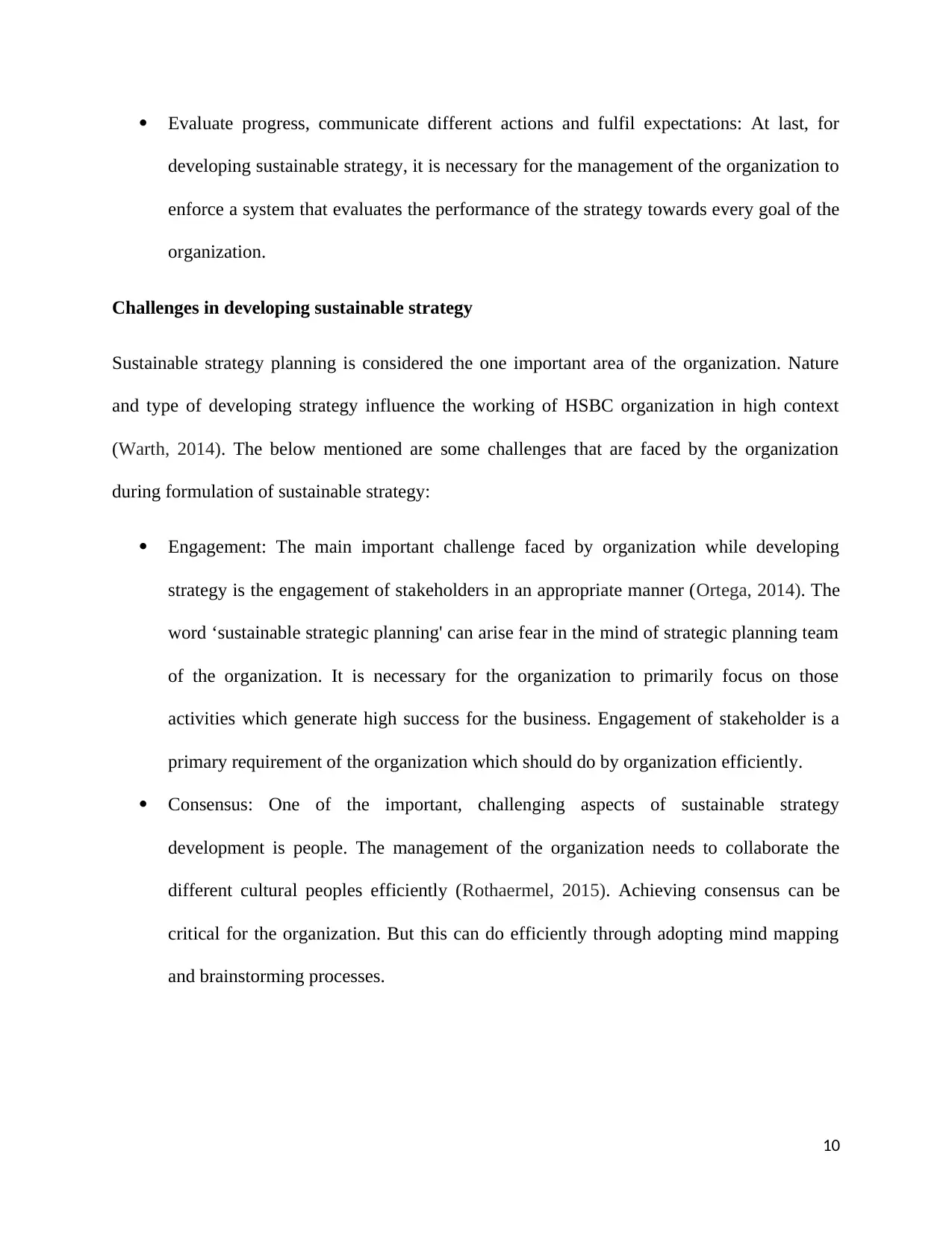
Evaluate progress, communicate different actions and fulfil expectations: At last, for
developing sustainable strategy, it is necessary for the management of the organization to
enforce a system that evaluates the performance of the strategy towards every goal of the
organization.
Challenges in developing sustainable strategy
Sustainable strategy planning is considered the one important area of the organization. Nature
and type of developing strategy influence the working of HSBC organization in high context
(Warth, 2014). The below mentioned are some challenges that are faced by the organization
during formulation of sustainable strategy:
Engagement: The main important challenge faced by organization while developing
strategy is the engagement of stakeholders in an appropriate manner (Ortega, 2014). The
word ‘sustainable strategic planning' can arise fear in the mind of strategic planning team
of the organization. It is necessary for the organization to primarily focus on those
activities which generate high success for the business. Engagement of stakeholder is a
primary requirement of the organization which should do by organization efficiently.
Consensus: One of the important, challenging aspects of sustainable strategy
development is people. The management of the organization needs to collaborate the
different cultural peoples efficiently (Rothaermel, 2015). Achieving consensus can be
critical for the organization. But this can do efficiently through adopting mind mapping
and brainstorming processes.
10
developing sustainable strategy, it is necessary for the management of the organization to
enforce a system that evaluates the performance of the strategy towards every goal of the
organization.
Challenges in developing sustainable strategy
Sustainable strategy planning is considered the one important area of the organization. Nature
and type of developing strategy influence the working of HSBC organization in high context
(Warth, 2014). The below mentioned are some challenges that are faced by the organization
during formulation of sustainable strategy:
Engagement: The main important challenge faced by organization while developing
strategy is the engagement of stakeholders in an appropriate manner (Ortega, 2014). The
word ‘sustainable strategic planning' can arise fear in the mind of strategic planning team
of the organization. It is necessary for the organization to primarily focus on those
activities which generate high success for the business. Engagement of stakeholder is a
primary requirement of the organization which should do by organization efficiently.
Consensus: One of the important, challenging aspects of sustainable strategy
development is people. The management of the organization needs to collaborate the
different cultural peoples efficiently (Rothaermel, 2015). Achieving consensus can be
critical for the organization. But this can do efficiently through adopting mind mapping
and brainstorming processes.
10
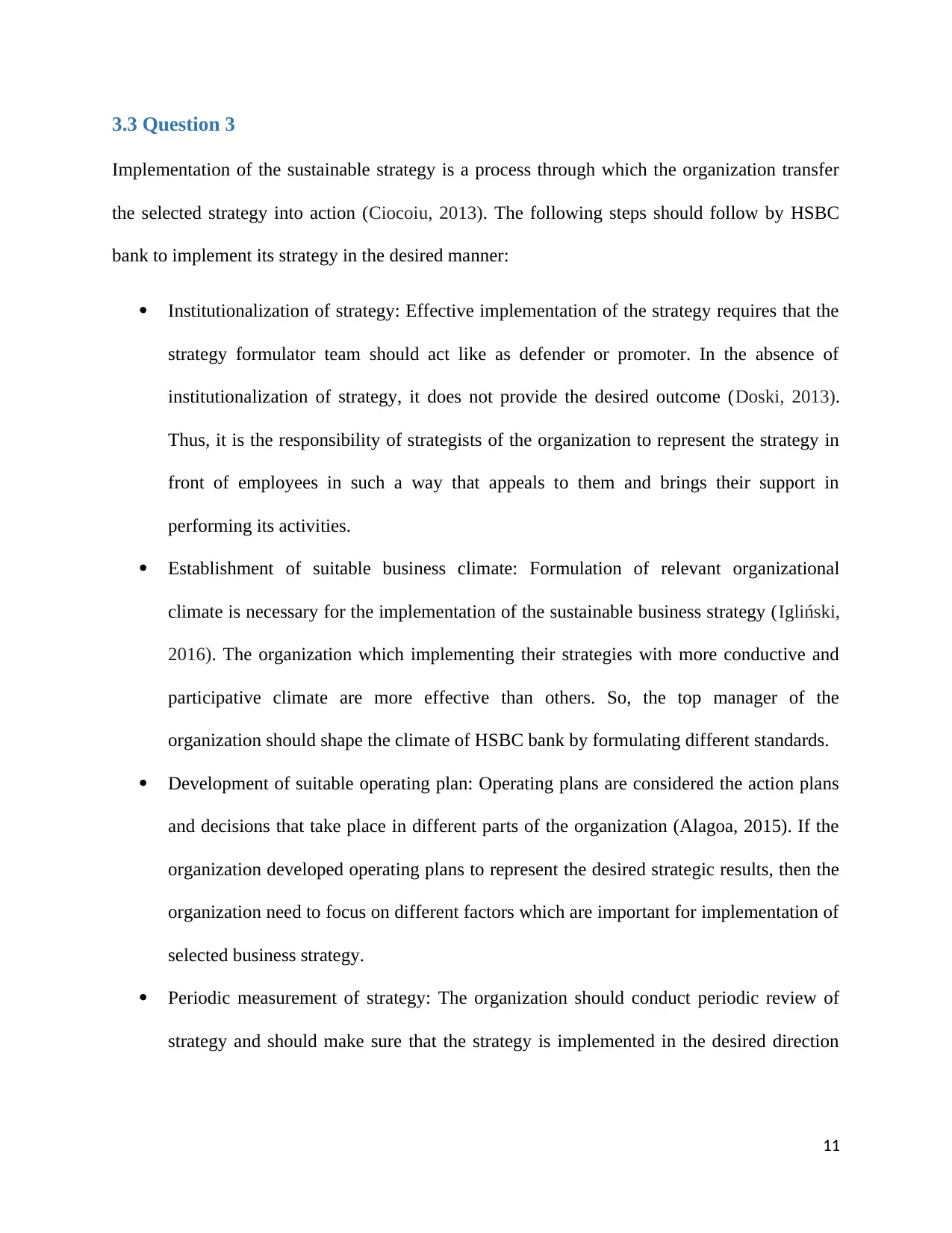
3.3 Question 3
Implementation of the sustainable strategy is a process through which the organization transfer
the selected strategy into action (Ciocoiu, 2013). The following steps should follow by HSBC
bank to implement its strategy in the desired manner:
Institutionalization of strategy: Effective implementation of the strategy requires that the
strategy formulator team should act like as defender or promoter. In the absence of
institutionalization of strategy, it does not provide the desired outcome (Doski, 2013).
Thus, it is the responsibility of strategists of the organization to represent the strategy in
front of employees in such a way that appeals to them and brings their support in
performing its activities.
Establishment of suitable business climate: Formulation of relevant organizational
climate is necessary for the implementation of the sustainable business strategy (Igliński,
2016). The organization which implementing their strategies with more conductive and
participative climate are more effective than others. So, the top manager of the
organization should shape the climate of HSBC bank by formulating different standards.
Development of suitable operating plan: Operating plans are considered the action plans
and decisions that take place in different parts of the organization (Alagoa, 2015). If the
organization developed operating plans to represent the desired strategic results, then the
organization need to focus on different factors which are important for implementation of
selected business strategy.
Periodic measurement of strategy: The organization should conduct periodic review of
strategy and should make sure that the strategy is implemented in the desired direction
11
Implementation of the sustainable strategy is a process through which the organization transfer
the selected strategy into action (Ciocoiu, 2013). The following steps should follow by HSBC
bank to implement its strategy in the desired manner:
Institutionalization of strategy: Effective implementation of the strategy requires that the
strategy formulator team should act like as defender or promoter. In the absence of
institutionalization of strategy, it does not provide the desired outcome (Doski, 2013).
Thus, it is the responsibility of strategists of the organization to represent the strategy in
front of employees in such a way that appeals to them and brings their support in
performing its activities.
Establishment of suitable business climate: Formulation of relevant organizational
climate is necessary for the implementation of the sustainable business strategy (Igliński,
2016). The organization which implementing their strategies with more conductive and
participative climate are more effective than others. So, the top manager of the
organization should shape the climate of HSBC bank by formulating different standards.
Development of suitable operating plan: Operating plans are considered the action plans
and decisions that take place in different parts of the organization (Alagoa, 2015). If the
organization developed operating plans to represent the desired strategic results, then the
organization need to focus on different factors which are important for implementation of
selected business strategy.
Periodic measurement of strategy: The organization should conduct periodic review of
strategy and should make sure that the strategy is implemented in the desired direction
11
⊘ This is a preview!⊘
Do you want full access?
Subscribe today to unlock all pages.

Trusted by 1+ million students worldwide
1 out of 27
Related Documents
Your All-in-One AI-Powered Toolkit for Academic Success.
+13062052269
info@desklib.com
Available 24*7 on WhatsApp / Email
![[object Object]](/_next/static/media/star-bottom.7253800d.svg)
Unlock your academic potential
Copyright © 2020–2025 A2Z Services. All Rights Reserved. Developed and managed by ZUCOL.





